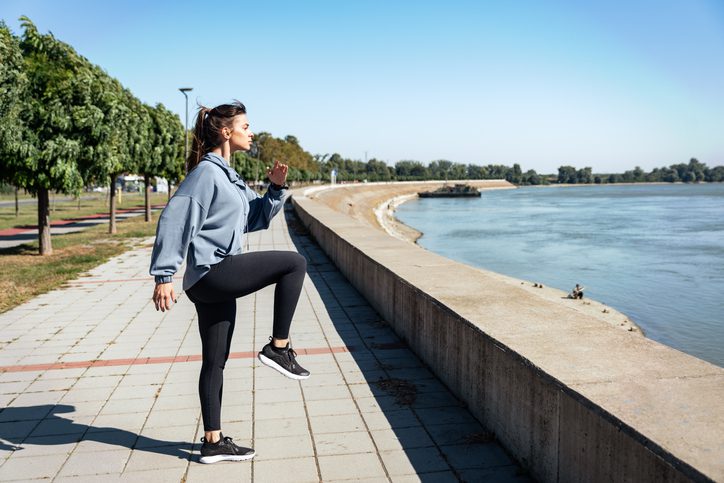Drills are the icing on the cake of a gentle, easy warmup pre-speedwork. Just like icing levels up your tasty treat to make it the best dessert it can be, tacking a few simple drills onto the end of your warmup sets your legs up to fire like never before, leading to a bigger improvement in performance and a more efficient workout. Try picking three drills to focus on, and feel free to do fewer repeats if these movements are new to you.

High knees
Practising high knees helps us learn to lift our knees up when we run and emphasizes remaining light on our feet.
In this drill, focus on driving the foot down and letting it spring back up off the ground, instead of lifting it using the knees. Use the same arm motion during this drill as you use while running.
Work on keeping the upper half of your body leaning slightly forward (bend at the hips, but not crouching over), avoiding the urge to lean back while lifting your knees high. Forget speed in this drill—your aim is to stay tall and light on your feet, creating a quick vertical force, while moving forward. Try 3 sets of 15-20 seconds of high knees.
Single-leg snap-downs
Running is a series of single-leg squats in a forward-moving direction, and any way you can improve co-ordination, balance and strength on one leg with help prevent injuries and maximize forward propulsion.
Begin by standing on both feet (if you feel balanced, come up onto your toes) with arms reaching above your head.
Once you find your balance, quickly drop onto one leg while pulling your arms down (into a running position) to create momentum. Release and begin again. Try 3 sets of 5 to 10 snap-downs on each side.
Backward running
Backward running helps stretch hip flexors while activating hamstrings, and builds leg strength while minimizing stress, making it a useful tool when returning from injury.
It’s important to keep safety in mind when you add backward running to your routine, and to start with a walk, rather than a run. If you’re outside, opt for a large open area free of obstacles, and ask a forward-walking friend to serve as your eyes.
If you are walking backward on a treadmill, begin by holding the handrails and walking at a low speed. As you become more accustomed to going backward, you can steadily increase the speed setting until you’re safely and slowly running backward. A five to 10-minute backward walking or running session several times a week is enough to get started and can be easily tacked on to the beginning or end of your regular running session.
A-skip
When doing the A-skip, pay attention to maintaining an upright posture and driving your arms forward, as when running. The idea is to skip while keeping knees high.
Practise in place by driving the knee up high above the hip and bringing it down fast. Once comfortable, a skip can be added in between steps.
While these drills are perfect to run through before a speed session, they can be slotted into the middle or end of an easy run. Remember to take a rest or easy running day after any harder workout or speed session.

